Police vehicles in Japan
Police Vehicles in Japan are vehicles used by the prefectural police officers used for patrolling consisting of wide variety of vehicles depending on the environment and situation.[1] Most police vehicles in Japan are manufactured by domestic automakers such as Toyota, Nissan or Subaru. Unlike how some departments in the U.S. and Canada allows their officers to take-home their police vehicles, Japan does not allow the officers to take home any kind of law enforcement vehicle. Every marked police patrol vehicles are in black-and-white two tone livery, motorcycles are usually all white. Vehicles for riot police units are painted blue and white, and especially vehicles for the Rescue Squads of the TMPD are painted green and white. The formal name is "警邏車" (keirasha),[2] but in general the abbreviation "パトカー (Hepburn: patokā)" is widely used.[2]
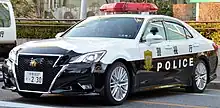
History
Beginning of police cars

The beginning of police cars in Japan was at the Asakusa police station in January 1949 (Shōwa 24). At the time of the turmoil after World War II, security was extremely bad even in Japan, with robberies and theft incidents.[3][4] Therefore, the local municipal police at that time painted the body of the car sold by the US military as "mobile police" or "移動警察" and introduced it as a trial, which is said to be the beginning of police cars in Japan.[3] After that, in June 1950 (Shōwa 25), the Tokyo Metropolitan Police Department, which had been the local police, deployed three so-called patrol cars, modified domestic cars with radios. The base car was a Nissan 180 truck designed during the war, and this chassis was covered with a sedan body. Additionally, the Korean War broke out almost at the same time as the deployment of police cars. In Japan, the Red Purge became popular under the MacArthur Directive, and the work of the municipal police increased more and more.
Body color of police cars
The iconic black-and-white two-tone of Japanese police cars had a big reason for it. Shortly after the war, some municipal police units used jeep-type vehicles painted white for transportation. However, since most of the domestic vehicles then were painted white,[5] and since roads at that time were unpaved, the vehicles were heavily damaged and polluted, and the police were troubled.[4] As a solution, American police cars were used as a reference. The sides and front of the body, which easily got dirty, were painted black, the roof was left white, and the hood were either painted black or white to easily be able to identify police vehicles.[6] This is the prototype of the “black and white two-tone” police car that continues to this day. However, the modified Nissan 180 that was first deployed was a white-green (some say white-blue) two-tone. This seems to have followed the pattern of the US-made police car that was used as a reference. It was in 1955 (Shōwa 30) that this two-tone color of police cars were unified nationwide[3][4] and it seems that it has taken root in the coloring of police cars in Japan today. If the US police cars that Japan used as a reference in the 1950s had a different coloring, the Japanese police cars would have been different.
Improvement
The first three police cars were poor quality and broke down frequently. The ride was uncomfortable, and it was hard work for the police. As a result, more and more police cars were based on Ford and Chevrolet vehicles sold by the US military.[7] The troubles did not end there. Due to the "risk of jamming/interception and monitoring communications (interception)'', the radios were taken down at the discretion of GHQ, so police cars often got lost, and was said that many vehicles fell into the fields on the way. It was necessary to wait until the end of the 1950s for VHF radios to be installed. In the 1960s, when the quality of domestic cars began to rise, police cars also began to be based on new domestic models.[4][7] First, Toyota Motor Co., Ltd.'s Toyota Patrol FS20 became the main force, which was based on the Crown and was equipped with Land Cruiser F type engine was deployed in large quantities. In addition, Nissan's Cedric and Isuzu Motors' Bellel were also adopted as base vehicles for police cars, and before long, only domestic models were used as police vehicles.
Many vehicles become bases

When the expressway system opened, sports cars also has been adopted as base cars for police cars. The Nissan Fairlady Z and the Toyo Kogyo (Later Mazda) Cosmo Sports, etc., were involved in speed control on expressways. In urban areas where illegal parking has begun to become a problem, light vehicle-based "kei-car" police cars, commonly known as "ミニパト (Hepburn: mini-pato)",[8] begun to play an active role. The base cars included the Suzuki Fronte and the Daihatsu Fellow Max,[4] and they were mainly driven by female police officers (they were called "婦警, Hepburn: fukei" at the time). From the end of the 70's to the 80's, some foreign police cars were revived. The Porsche 911 and BMW 3 series were painted in black and white as marked cars, and Mercedes-Benz vehicles including the W124, was deployed as a unmarked police car. The most notable and famous of these is probably the Niigata Prefectural Police's 1978 Porsche 911SC.[4] This model, which was deployed when the Hokuriku Expressway opened, has also been used as a PR vehicle for the prefectural police and has been in use for over 20 years, which is very unusual for police cars.
Types
A patrol car in the Japanese police force is a police vehicle designated as an emergency vehicle and is abbreviated as "パトカー (Hepburn: patokā)". "PC[9]" is commonly used in police terminology, and is commonly used in police radio.
The patrol cars are mainly divided into marked "uniformed" police cars (black and white two-tone color[10] with a red rotating lightbar fixed to the roof or equipped with a red rotating light that can be deployed) and unmarked police cars (equipped with a red revolving warning light connected by a cable, usually portable and stored inside the car and attached to the roof of the vehicle with a suction cup when necessary, or a red revolving warning light that is stored in the roof, rotates and comes out of the roof when necessary.)
Unlike fire trucks and ambulances, patrol cars often seen in the city are operated as "mobile police (regional police)", and they patrol the city to detect crimes rather than waiting at police headquarters, police stations, and other government buildings. It patrols the streets to prevent crimes and accidents, and prepares to quickly get to the scene whenever an emergency call is made. In addition, the "traffic police (Traffic Enforcement, Expressway Patrol, police station traffic department)" and "criminal police (Mobile Investigation Unit, police station detectives department)" not only carry out crackdowns, security, and investigations in the city, but also an operational purpose to quickly reach the site from the city.
Black-and-white Patrol/Traffic Police Car
Patrol cars

This is a police car operated by a uniformed police officer, usually two uniformed police officers ride (some rural residential police boxes may have one person). It is assigned to the police station's regional department mobile patrol officer, Traffic Department, Mobile Patrol Unit, Expressway Patrol, etc. Officially, vehicles for traffic enforcement are called "four-wheeled vehicle for traffic enforcement (radio vehicle for traffic enforcement), Japanese: 交通取締用四輪車(交通取締用無線自動車),[11] Hepburn: kōtsū-torishimariyō-yonrinsha (kōtsū-torishimariyō-musen-jidōsha)", and those mainly for patrol are called "radio patrol vehicle (radio car for patrol), Japanese: 無線警ら車(警ら用無線自動車),[11] Hepburn: musen-keirasha (keirayō-musen-jidōsha)". In other words, it means it is a car used for traffic enforcement or patrol activities, equipped with a radio for each police department/division. It is a car for official duties such as patrol and traffic control in the city as mentioned above, and it is not a "police officer's" but a car for each enforcement activity of the police department. There are about 9,000 police cars that are purchased with national funds and are deployed in various places nationwide, excluding unmarked police cars.[10]
As of 2022, Toyota Crown is the main marked police car operated in each prefecture, however Subaru Legacy is on the decline, and Yamanashi Prefectural Police operates Toyota Mark X. In addition, the Saitama Prefectural Police operates Nissan Teana as their patrol vehicle.

This is the most common and numerous patrol car in the Japanese police force, and it is mainly used in the police activities of the local police, the deterrence of accidents and violations of the traffic police, and the investigation and crime vigilance activities of the detective department. When tailing a suspect in a criminal investigation, it is necessary to conceal the identity of the police from the suspect, so a unmarked police car is used, but in other cases it is a police vehicle rather than an undercover vehicle, so other investigation and crackdowns are carried out in an easy-to-understand marked police car.
Design of black-and-white vehicles
Regarding the design of the vehicle, the National Police Agency has a guideline that "the body is painted in black and white, equipped with red warning lights and loudspeakers on the top (roof) and front, and the name of the prefecture is written on the side''.
As stated above, in 1955 (Shōwa 30), in order to distinguish police vehicles from other cars which were mostly white at the time,[5] the lower half was colored with black paint to make damage and dirt less noticeable, considering the road conditions at the time, when there were many unpaved roads.[6] However, there are no detailed regulations, and each prefectural police has a slightly different way of coloring and the shape of the emergency lightning etc.

For the character notation on the side, it is divided into "○○県(府)警 (○○-ken (fu) kei)" (example: 大阪府警, Hepburn: Osaka-fukei) and "○○県(北海道)警察 (○○-ken (Hokkaido) keisatsu)" (example: 神奈川県警察, Hepburn: kanagawa-ken-keisatsu). The Kagawa Prefectural Police used to be '香川県警 (Hepburn: kagawa-ken-kei)', but recently introduced vehicles have been changed to "香川県警察 (Hepburn: kagawa-ken-keisatsu). There are also various types of fonts, but in some areas, such as the Ishikawa Prefectural Police, they changed from Ming to Gothic. Currently, only a few departments, such as the Kagoshima Prefectural Police and the Kumamoto Prefectural Police, use the Ming typeface. The Gifu Prefectural Police is the only department in Japan that has their department name written in white on the bottom of the front door only for the Expressway Patrol units, and has no "POLICE" notation. The Aomori Prefectural Police has a white swan illustration on the bottom of the front door.[12] The Ōita Prefectural Police used to have a vehicle equipped with a mixture of red and blue warning lights like American police vehicles, but these vehicles were used for guarding the Imperial House. Normally, it is customary for the marked patrol cars, which are usually in charge of leading the convoy in the Imperial motorcade, to use cars with one side or part of the lightbar or its cover changed to blue, but in recent years, the red lights have been left as they are, and the method of adding a detachable streamlined blue warning light became mainstream. In December 2008 (Heisei 20), when guarding the China-Japan-South Korea Summit Meeting held in Fukuoka Prefecture, it was equipped with warning lights of different colors for each country in order to identify the vehicles to be guarded. Japan used red and blue mixed front warning lights, for South Korea used red and blue mixed warning lights, and for China used red and green mixed warning lights.
In addition, some police cars owned by the U.S. Forces in Japan are equipped with blue and red warning lights (in the United States, red flashing lights are for emergency vehicles, and blue flashing lights are for police cars, so both are used). Also, in 2007, the Tokyo Metropolitan Police Department decided to use a yellow reflective material for the letters "POLICE" on the left and right doors and the rear bumper, so that foreigners could recognize it as a police car and for reasons such as improving visibility, and decal graphics made of reflective material with a design of the insignia on the police notebook.[13] Police cars are not equipped with red warning lights and sirens because they are police vehicles, but rather installed as safety equipment for emergency driving of emergency vehicles stipulated by the Road Traffic Act. In order to prevent the police car from causing an accident when traveling at high speed while responding to the destination, the safety equipments (warning lights and sirens) are equipped to warn other vehicles and pedestrians on the road that there is a police vehicle responding by sight (light of warning light) and hearing (sound of siren).
Displacement and its purpose
Police cars differ in displacement and output depending on the type and purpose. In descending order, Expressway Patrol/Traffic Enforcement police car (displacement 3,500-2,000 cc), patrol car (2,500-1,900 cc), mini police car (so-called "mini-pato", 1,500-660 cc). For this reason, there are mainly no vehicle transfer across divisions and/or departments (e.g. vehicle transfer from Mobile Patrol Division to Expressway Patrol)[Note 1], so a new orders are placed for dedicated vehicles for each unit. However, there are cases where sports cars are ordered by donation or by the prefectural police's own policy, and among them, Nissan Fairlady Z has a track record of introducing all successive models as police cars.
Unit numbers
In addition, many patrol cars have the affiliated police station/unit name abbreviation (code) and vehicle identification number written on the roof, and the TMPD and some police headquarters also have this notation on the windshield. For example, if unit 1 belonging to the Kōjimachi Police Station of the TMPD has "麹町1" (Hepburn: "Kojimachi 1") on the windshield, "麹1" ("Kōji 1") on the roof, "302" for "keishi" unit 302, which belongs to Headquarters, "高速3" (kōsoku 3) for unit No. 3 belonging to the Expressway Patrol, "速3" (soku 3) on the roof, etc.
Since it also serves as an identification signal for police radios, police officers are required to give their unit number (call sign) at the beginning of any radio communication. For example, in the case of the Keishi No. 217 car of the TMPD, it would be "From Keishi 217 to TMPD, turning left near the 〇〇 intersection and heading south." In particular, the unit number on the roof is called "aircraft notation", and it is intended for the air crew to easily see and understand which unit when operating a helicopter communicates with the vehicle on the ground by radio. Therefore, basic police radios are mostly not installed in traffic enforcement vehicles such as "mini-pato"s, and many Kōban police boxes or police station vehicles do not have aircraft notation. It is usually not displayed on unmarked police cars because it would break the purpose of being concealed.
High-performance vehicles
.jpg.webp)
Some prefectural police forces have operated numerous high-performance police vehicles in their fleets, with a notable example being the Tochigi Prefectural Police. High-performance vehicles operated by these forces include the Nissan Skyline GT-R R34, Nissan GT-R R35, Subaru Impreza WRX STi, Honda NSX, Nissan 370z and Lexus LC 500. Alongside regular use for traffic enforcement on the various expressways of Japan, these high-performance vehicles are often used for publicity and ceremonial purposes. On some occasions, these vehicles have donated to prefectural police forces by either private owners or vehicle manufacturers.[14][15][16]
Throughout the 1960s and 1970s, Japanese police used Ford Mustangs such as the Ford Mustang Mach 1.[17]
"Mini-pato" mini police cars
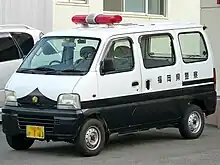
"Mini-pato" mini police cars got its name from the Japanese term for police car "パトカー (Hepburn: patokā), and "mini" added onto it since it is a compact car mainly used for traffic enforcement, Kōbans, and other purposes that does not need full-sized police vehicles. Mini-patos are vehicles 1,500 cc or less, total length of 4,500 mm or less and fits within the "5-number" vehicle class code size frame (There are exceptions such as the Suzuki SX4, which is treated as 3 numbers with a total width exceeding 1,700 mm.) This is a police car using a compact car or light "kei"car, and has two types of marked "uniformed" police car and marked police car, however in general, what is called a mini-pato in the field is a "small patrol vehicle" deployed at Kōban police boxes or police stations relatively far from the main station, and/or light vehicles that is used exclusively for the enforcement of illegal parking and for controlling and directing traffic on the street - marked police car of about 1,500 cc (It seems that it is often called "mini pato" even by the officers). The former, called a "compact patrol vehicle", was deployed for the first time in 1974 to 100 police stations with severe road and weather conditions nationwide (Shōwa 50 edition "White Paper on Police"). A large number of 1,000 cc - 1,500 cc class vehicles were introduced by the government (National Police Agency) at national expense and deployed nationwide, so there are relatively many opportunities to see them on the streets of Japan. Depending on the fiscal year, bidding may be done with 4WD designation, and if bidding for 2WD vehicles is also done, two models may be deployed in that fiscal year.
In addition, there are quite a few procurements with prefectural expenses, and in that case, models different from those procured by the government may be introduced. The latter, which is often called a "mini-pato" in the field, often adopts a kei-car, especially in large metropolitan areas such as the Tokyo Metropolitan Police Department, since it is effective on congested roads where it is difficult to secure even a space for full-sizedpatrol cars to stop during enforcements. In local cities, there is a tendency to adopt a class so-called liter car, and it seems that durability is taken into account because the jurisdiction is wide and the travel distance is relatively long. Since most of the procurement is funded by prefectural governments, there is no standardized model nationwide. Equipped with a red revolving light and a siren amplifier, it is designated as an emergency vehicle by the Road Traffic Act Ordinance.
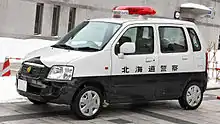
Common national-funded mini-patos (small patrol vehicles)
- Toyota Passo (2007/2008/2009/2012)
- Toyota Platz (2001/2004)
- Honda Insight (2009)
- Suzuki Swift (2000/2002/2003/2005/2015/2018/2019/2020)
- Suzuki Solio (2006/2007/2009/2011/2013/2014/2017)
Prefectural-funded mini-patos
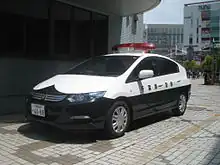

_used_as_Osaka_Prefectural_Police_automobile.jpg.webp)
☆ is a light "kei-car", ★ is a compact car with a "3-number" standard body
- Toyota Starlet
- Daihatsu Cami
- Daihatsu Rush
- Toyota Vitz (KSP90/NCP95)
- Toyota Belta (NCP96)
- Toyota FunCargo
- Toyota ist
- Toyota Corolla Axio/Corolla Axio EX (NZE164)
- Nissan March
- Nissan Cube
- Nissan Note
- Nissan Sunny (FB15)
- Nissan Pulsar Sedan (N14/N15)
- Nissan Tiida Latio
- Nissan Latio
- Mazda Demio
- Mitsubishi Toppo BJ ☆
- Mitsubishi Colt
- Mitsubish Lancer Sedan (excluding Sedia)
- Suzuki Kei ☆
- Subaru Impreza Sedan (2nd generation 1.5L model only)
- Subaru Justy (Japan spec 2nd generation only)
- Subaru Pleo (first generation only)
- Daihatsu Sharade Social
- Daihatsu Storia
- Daihatsu Atrai7
- Daihatsu Terios
- Daihatsu Terios Kid ☆
- Daihatsu Boon
- Daihatsu Be-go
- Daihatsu Thor
- Suzuki Cultus Esteem/Cultus Crescent/Cultus Sedan
- Suzuki Aerio/Aerio Sedan
- Suzuki SX4 ★/SX4 Sedan ★
- Suzuki Ignis
- Suzuki Hustler ☆
- Suzuki Xbee
- Suzuki Baleno ★
- Suzuki Jimny Sierra (Including Jimny Wide)
- Mazda Demio
- Mazda Axela Sedan (first generation 1.5L model only) ★
- Honda Vezel
Additionally, kei-cars such as Daihatsu Mira (including Gino, e:S, Tocot), Esse, Cast (Style), Hijet Cargo, Mistubishi Minica, Suzuki Alto (including Lapin), and Every are often seen especially in metropolitan areas such as the Tokyo Metropolitan Police Department.
Regarding about the equipment, it is usually simpler than a marked police car such as an Crown called a radio patrol vehicle, and it is often not equipped with a speed radar or an in-vehicle radio. For this reason, many police headquarters have established guidelines for the operation of small patrol vehicles, requiring police officers riding in them to carry portable radios or radio receivers. Antenna(s) are installed in many vehicles, and it is often operated by connecting the cable to the radio. Some vehicles are equipped with data communication terminals and car location systems.
Also, in recent years, radio patrol vehicles have been equipped with navigation systems, but they are rarely equipped most likely because they are not so necessary due to operational characteristics. Unlike radio patrol vehicles, it is based on a publicly-available vehicles rather than a "police package" trim, so the equipment of the base car is left as it is. The red warning light is equipped with a small diffused warning light, but the boomerang "V-type" type is the same as other police cars.
Unmarked "masked patrol" police car

A unmarked police car has the same appearance as a normal civilian vehicle in normal times, and refers to a police car that exposes a red light and sounds a siren only when in case of an emergency. Since it is possible to tail a suspicious vehicle or a suspicious person without being noticed that it is a police car, which means there is little possibility that the target will know it is a police vehicle and possibly escape.
Formally and officially, unmarked vehicles used for traffic enforcement are called "four-wheeled vehicle for traffic enforcement (rotating warning light), (Japanese: 交通取締用四輪車(反転警光灯)",[11] Hepburn: kōtsū-torishimariyō-yonrinsha (hanten-keikōtō))", a "escort vehicle (Japanese: 警護車, Hepburn: keigo-sha)", and vehicles used for criminal investigations are called "investigation vehicle" (Japanese: 捜査用車 Hepburn: sousayō-sha)". These three types of vehicles are collectively called unmarked police vehicles and sometimes simply abbreviated as "unmarked (Japanese: 覆面, Hepburn: fukumen)" or "unmarked car (Japanese: 覆面車, Hepburn: fukumen-sha"). However, among the "investigation vehicles", there are normal vehicles that are not designated as emergency vehicles (emergency driving certification) and are not equipped with detachable red rotating lights and sirens. In addition, the police officers who operate in unmarked cars do not necessarily wear police uniforms, and they may patrol in the same clothes as ordinary people as "plain clothes police officers". It is common for the unmarked vehicle members of the patrol and Traffic Enforcement Units to wear uniforms and helmets, and the members of the Mobile Investigation Units to wear suits, but in some cases they are plain clothes.

Distinctive characteristics

As a distinctive freature on the exterior, there are antenna(s) for police radio.[18] Normally, a camouflaged antenna that does not make you think that it is equipped with a radio is used. In the old days, the "F-1 type antenna" that imitated a radio antenna attached to the fender and the type that imitated a personal radio antennas were used, and in the 1990s, the "TL antenna" that imitated a car phone antenna became mainstream.
For each of them, due to disadvantages of "since the original radio antenna exists, it looks like there are two radio antennas", "decrease in general vehicles equipped with personal radio", "decrease in car phones due to the spread of mobile phones, and low spread rate of the same type antenna as mobile phone options", it became widely spread and recognized by the general public that antennas are "like the symbol of the unmarked police car", and lacks confidentiality. For this reason, since the early 2000s, it has been replaced with a "TA antenna" that is disguised as the diversity antenna of an in-vehicle analog TV.[18][19]
However, with the start of the digital television broadcasting in Japan, film antennas have become more mainstream for television viewing in general vehicles, and the confidentiality of the TA type has also declined, so film antennas adjusted to the frequency of police radios and plastic-outer short rod-shaped antennas commonly known as "euro antennas" (manufactured by Nippon Antenna: MG-UV-TP, WH-UV-TP, etc.), which are currently the mainstream of radio antennas. However, as an exception, some prefectural police use antennas disguised as whip antennas for amateur radio.
Four-wheeled vehicle for traffic enforcement (rotating warning light)

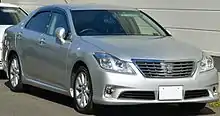
The four-wheeled vehicle for traffic enforcement (rotating warning light) has a red warning light stored in the roof of the vehicle, just like a escort vehicle (It is called the "rotating type" because it used to be stored 180 degrees in the roof, but the current type is lying on its side in the storage space and exposed to the outside by a link mechanism that interlocks with the movement of the lid to open). In addition, it seems that very early unmarked
police cars' rotating light only ascended and descended and did not rotate up into position,[20] and you can watch the video of the masked police car introduced in 1967.
Unmarked traffic patrol cars are deployed in Traffic Enforcement Units (traffic corps), Expressway Patrol (high-speed corps), and traffic departments of police stations (district police stations), and mainly carry out traffic control and enforcement. Vehicles in units such as traffic enforcement unit that enforce traffic violations have a red warning light stored in the center of the roof that automatically rotates and rises when a switch is operated inside the vehicle. Therefore, there is a recess/void (sometimes called a "washbowl" due to its shape) in the roof of the car where the rotating light is stored.
In addition, the police officers riding in the car primarily to wear the blue uniform of the traffic enforcement unit or the black uniform made of synthetic leather in principle, so if you look closely inside the car, you can tell that it is a police vehicle. As an exception, there are vehicles that use magnet-type red lights in the same way as investigation vehicles, such as vehicles for fighting against bōsōzoku motorcycle gangs (maru-sou) in various places and even the Traffic Enforcement Units can be dispatched in plain clothes. Some vehicles have a function to display "FOLLOW ME" or "SLOW DOWN" on the electric display board installed in the rear tray.
Unmarked traffic police cars, like marked police cars, have their own grades for each automaker. However, since there is less demand than marked police cars, there are fewer models, and currently only the Toyota Crown is set as a catalog model. However, as described in the marked police car section, the majority of cases are purchased by the prefectural police unit, purchased in bulk by the National Police Agency through general competitive bidding, or donated, so there are also many unmarked police cars based on general civilian vehicles. During the bubble economy, in order to reduce the trade surplus, there were cases in which foreign-made luxury vehicles such as Mercedes-Benz and BMW were purchased with government funds and deployed in the expressway patrol units of major prefectural police.
The vehicle price is 33,311,640 yen for 4 units (8,327,910 yen per unit), as an example of the Toyota Mark X purchased by the Tokyo Metropolitan Police Department and deployed to the traffic riot police in 2016. However, it is a sports model equipped with a 3.5-liter V6-cylinder engine, a specially developed supercharger and ECU, and a special specification with increased torque and horsepower[21].
 A twelfth generation Crown with an "auto-cover" warning light in the front bumper and TA antennas on the left and right sides of the upper rear glass
A twelfth generation Crown with an "auto-cover" warning light in the front bumper and TA antennas on the left and right sides of the upper rear glass A twelfth generation Crown with warning lights in the front grill and TA antennas on the left and right sides of the rear glass
A twelfth generation Crown with warning lights in the front grill and TA antennas on the left and right sides of the rear glass A twelfth generation Crown for traffic enforcement of the TMPD with TA antennas
A twelfth generation Crown for traffic enforcement of the TMPD with TA antennas
Notes
References
- 『広辞苑』第六版「パトロールカー」、『明鏡国語辞典』第二版「パトロールカー」。
- デジタル大辞泉「パトロールカー」
- "昔は「白」だった!! パトカーの白黒パンダカラーはいつから始まった". 自動車情報誌「ベストカー」 (in Japanese). 26 July 2021. Retrieved 4 May 2023.
- "警察車両(パトカー)の歴史 | 名車文化研究所". meisha.co.jp (in Japanese). Retrieved 4 May 2023.
- 『朝日新聞』「しつもん!ドラえもん」(Unknown date)
- "パトカーの沿革(警察の歴史-制服、パトカー、白バイ)". 警視庁. Retrieved 1 February 2018.
- "別冊ベストカー". 平成〜令和新時代 パトカー30年史 (in Japanese) (2nd ed.). Kodansha. 3 December 2022. p. 32. ISBN 978-4-06-515554-7.
- 交通タイムス社. "緊急走行できないパトカーがあった! 軽やコンパクトカーベースの「ミニパト」の仕事とは". WEB CARTOP (in Japanese). Retrieved 7 May 2023.
- "警察のホント・ウソ - 岡山県警察 採用情報 - 岡山県ホームページ(警務部警務課)". www.pref.okayama.jp. Retrieved 17 February 2019.
- 【ニュースの門】パトカー不審者は見逃さぬ『読売新聞』朝刊2021年4月13日(解説面)
- 交通タイムス社. "警察も使う「覆面パトカー」は通称! 意外と知らない「正式な名称」とは". WEB CARTOP (in Japanese). Retrieved 12 May 2023.
- "パトカーのドアに全国唯一のビッグマーク 「らしさ」貫く青森の警察車両 県警に聞いた". 乗りものニュース (in Japanese). Retrieved 9 May 2023.
- パトカー側面に「POLICE」文字 視認性向上へ 共同通信(2007年2月8日)
- Okulski, Travis (6 December 2018). "Japan's R34 Skyline GT-R Cop Car Is Real and Spectacular". Road and Track. Retrieved 18 June 2023.
- McEachern, Sam (15 June 2018). "Japan Just Put an R35 Nissan GTR Police Car Into Service". AutoGuide. Retrieved 18 June 2023.
- Takuji Hiraga (2 January 2022). "Tochigi police use luxury, speed of patrol fleet to promote safety". The Asahi Shinbun. Retrieved 18 June 2023.
- Demorro, Chris (5 October 2012). "Japan Apparently Used Classic Mustangs As Cop Cars". Street Muscle Magazine. Retrieved 18 June 2023.
- "警察マニア予備軍以外、誰得!? 細かすぎる覆面パトカーの見分け方". 自動車情報誌「ベストカー」 (in Japanese). 11 November 2021. Retrieved 12 May 2023.
- "パトカーの装備(無線アンテナ)". policecar.nomaki.jp. Retrieved 12 May 2023.
- KBCアーカイブズ九州朝日放送
- ニッポン警察史上“最速覆面パトカー”の正体は「スーパーチャージャー搭載360馬力の本気仕様マークX」日刊SPA!(2017年2月26日)2017年2月26日閲覧